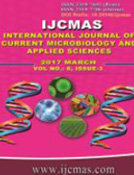


 National Academy of Agricultural Sciences (NAAS)
National Academy of Agricultural Sciences (NAAS)

|
PRINT ISSN : 2319-7692
Online ISSN : 2319-7706 Issues : 12 per year Publisher : Excellent Publishers Email : editorijcmas@gmail.com / submit@ijcmas.com Editor-in-chief: Dr.M.Prakash Index Copernicus ICV 2018: 95.39 NAAS RATING 2020: 5.38 |
A field investigation was carried out at college farm, Professor Jayashankar Telangana State Agricultural University, Rajendranagar, Hyderabad during 2014-15 and 2015-16 with five tillage treatments CT (transplanted), CT (transplanted), CT (direct-seeded), ZT (direct-seeded) and ZT+R (direct-seeded) for kharif rice fb CT, ZT, CT, ZT+R and ZT+R treatments for rabi maize in sequence as main treatments and 3 weed management practices (chemical method, IWM and weedy check) as subplots in split plot design replicated thrice. Mean data of system productivity (rice-maize-green manure (dhaincha) system) and economic analysis showed that, more system productivity, net returns and B C ratio was obtained under conventional tillage (CT) kharif transplanted rice followed by rabi maize under conventional tillage (12777 kg ha-1, Rs 1, 09,003 ha-1 and 2.53) and zero tillage maize cultivation respectively (11455 kg ha-1, Rs 93,994 ha-1 and 2.39). Integrated weed management practices recorded more system productivity, net returns and BC ratio (12126 kg ha-1, Rs 1, 02, 625 ha-1 and 2.51) for kharif aerobic/transplanted rice (bispyribac sodium 25 g/ha as early PoE at 15 DAT fb HW at 40 DAT) followed by rabi maize (atrazine 1000 g ha-1+paraquat 600g ha-1 as PE fb HW at 40 DAS) in sequence respectively.
 |
 |
 |
 |
 |